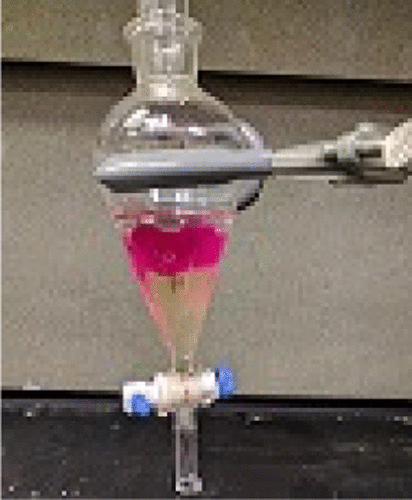当前位置:
X-MOL 学术
›
J. Phys. Chem. B
›
论文详情
Our official English website, www.x-mol.net, welcomes your
feedback! (Note: you will need to create a separate account there.)
Anomalous Solubility of an Inert Solid in a Binary Liquid Mixture with a Critical Point of Solution
The Journal of Physical Chemistry B ( IF 2.8 ) Pub Date : 2018-02-20 00:00:00 , DOI: 10.1021/acs.jpcb.7b11058 James K. Baird , Joshua R. Lang , Xingjian Wang , Sijay Huang , Anusree Mukherjee
The Journal of Physical Chemistry B ( IF 2.8 ) Pub Date : 2018-02-20 00:00:00 , DOI: 10.1021/acs.jpcb.7b11058 James K. Baird , Joshua R. Lang , Xingjian Wang , Sijay Huang , Anusree Mukherjee

|
We consider the dissolution of a chemically inert solid in a binary liquid mixture with a critical point of solution. When the mixture, acting as the solvent, has come to equilibrium with the solid, the state of the system is completely described by the temperature, pressure, and a concentration variable formed by dividing the molar amount of one solvent component by that of the other. Under conditions of fixed pressure, the principle of critical point isomorphism predicts that the slope of a van’t Hoff plot of the solubility of the solid should diverge toward infinity as the temperature enters the critical region. The sign of the divergence is negative when the dissolution is endothermic, whereas it is positive when the dissolution is exothermic. In experiments where excess solid phenolphthalein dissolves in a binary mixture of nitrobenzene + dodecane, we have observed exothermic dissolution concurrently with a positive divergence of the van’t Hoff slope. The data are insufficiently precise to compute an accurate numerical value for the exponent of the temperature power law expected to govern this divergence; nevertheless, on the basis of Widom scaling theory, we argue that the exponent should be equal to 0.326, which is identical to the value of the exponent that governs the temperature dependence of the shape of the liquid–liquid coexistence curve. Being entirely physical in nature, the anomalous solubility effect should be observable in the case of any chemically inert solid dissolving in any one of the more than 1000 liquid pairs known to have a critical point of solution.
中文翻译:

具有临界点的二元液体混合物中惰性固体的反常溶解度
我们考虑将化学惰性的固体溶解在具有临界溶液点的二元液体混合物中。当作为溶剂的混合物与固体达到平衡时,系统的状态完全由温度,压力和浓度变量来描述,该浓度变量是通过将一种溶剂成分的摩尔量除以另一种溶剂成分的摩尔量而形成的。在固定压力的条件下,临界点同构原理预测,随着温度进入临界区,固体溶解度的范特霍夫图的斜率应趋于无穷大。当溶出是吸热时,发散的符号为负,而当溶出为放热时,其发散的符号为正。在实验中,过量的固体酚酞溶解在硝基苯+十二烷的二元混合物中,我们观察到放热溶解,同时范氏霍夫斜率呈正偏差。数据不够精确,无法为控制这种差异的温度幂定律的指数计算出准确的数值;但是,基于Widom缩放理论,我们认为指数应等于0.326,该指数等于控制液-液共存曲线形状的温度依赖性的指数值。本质上完全是物理的,在任何化学惰性固体溶解在已知具有临界溶液点的1000多种液体对中的任何一种中的情况下,异常溶解度效果都应可观察到。我们观察到放热溶解与van't Hoff斜率呈正偏差同时发生。数据不够精确,无法为控制这种差异的温度幂定律的指数计算出准确的数值;但是,基于Widom缩放理论,我们认为指数应等于0.326,该指数等于控制液-液共存曲线形状的温度依赖性的指数值。本质上完全是物理的,在任何化学惰性固体溶解在已知具有临界溶液点的1000多种液体对中的任何一种中的情况下,异常溶解度效果都应可观察到。我们观察到放热溶解与van't Hoff斜率呈正偏差同时发生。数据不够精确,无法为控制这种差异的温度幂定律的指数计算出准确的数值;但是,基于Widom缩放理论,我们认为指数应等于0.326,该指数等于控制液-液共存曲线形状的温度依赖性的指数值。本质上完全是物理的,在任何化学惰性固体溶解在已知具有临界溶液点的1000多种液体对中的任何一种中的情况下,异常溶解度效果都应可观察到。数据不够精确,无法为控制这种差异的温度幂定律的指数计算出准确的数值;但是,基于Widom缩放理论,我们认为指数应等于0.326,该指数等于控制液-液共存曲线形状的温度依赖性的指数值。本质上完全是物理的,在任何化学惰性固体溶解在已知具有临界溶液点的1000多种液体对中的任何一种中的情况下,异常溶解度效果都应可观察到。数据不够精确,无法为控制这种差异的温度幂定律的指数计算出准确的数值;但是,基于Widom缩放理论,我们认为指数应等于0.326,该指数等于控制液-液共存曲线形状的温度依赖性的指数值。本质上完全是物理的,在任何化学惰性固体溶解在已知具有临界溶液点的1000多种液体对中的任何一种中的情况下,异常溶解度效果都应可观察到。我们认为指数应等于0.326,这与控制液-液共存曲线形状的温度依赖性的指数值相同。本质上完全是物理的,在任何化学惰性固体溶解在已知具有临界溶液点的1000多种液体对中的任何一种中的情况下,异常溶解度效果都应可观察到。我们认为指数应等于0.326,这与控制液-液共存曲线形状的温度依赖性的指数值相同。本质上完全是物理的,在任何化学惰性固体溶解在已知具有临界溶液点的1000多种液体对中的任何一种中的情况下,异常溶解度效果都应可观察到。
更新日期:2018-02-20
中文翻译:

具有临界点的二元液体混合物中惰性固体的反常溶解度
我们考虑将化学惰性的固体溶解在具有临界溶液点的二元液体混合物中。当作为溶剂的混合物与固体达到平衡时,系统的状态完全由温度,压力和浓度变量来描述,该浓度变量是通过将一种溶剂成分的摩尔量除以另一种溶剂成分的摩尔量而形成的。在固定压力的条件下,临界点同构原理预测,随着温度进入临界区,固体溶解度的范特霍夫图的斜率应趋于无穷大。当溶出是吸热时,发散的符号为负,而当溶出为放热时,其发散的符号为正。在实验中,过量的固体酚酞溶解在硝基苯+十二烷的二元混合物中,我们观察到放热溶解,同时范氏霍夫斜率呈正偏差。数据不够精确,无法为控制这种差异的温度幂定律的指数计算出准确的数值;但是,基于Widom缩放理论,我们认为指数应等于0.326,该指数等于控制液-液共存曲线形状的温度依赖性的指数值。本质上完全是物理的,在任何化学惰性固体溶解在已知具有临界溶液点的1000多种液体对中的任何一种中的情况下,异常溶解度效果都应可观察到。我们观察到放热溶解与van't Hoff斜率呈正偏差同时发生。数据不够精确,无法为控制这种差异的温度幂定律的指数计算出准确的数值;但是,基于Widom缩放理论,我们认为指数应等于0.326,该指数等于控制液-液共存曲线形状的温度依赖性的指数值。本质上完全是物理的,在任何化学惰性固体溶解在已知具有临界溶液点的1000多种液体对中的任何一种中的情况下,异常溶解度效果都应可观察到。我们观察到放热溶解与van't Hoff斜率呈正偏差同时发生。数据不够精确,无法为控制这种差异的温度幂定律的指数计算出准确的数值;但是,基于Widom缩放理论,我们认为指数应等于0.326,该指数等于控制液-液共存曲线形状的温度依赖性的指数值。本质上完全是物理的,在任何化学惰性固体溶解在已知具有临界溶液点的1000多种液体对中的任何一种中的情况下,异常溶解度效果都应可观察到。数据不够精确,无法为控制这种差异的温度幂定律的指数计算出准确的数值;但是,基于Widom缩放理论,我们认为指数应等于0.326,该指数等于控制液-液共存曲线形状的温度依赖性的指数值。本质上完全是物理的,在任何化学惰性固体溶解在已知具有临界溶液点的1000多种液体对中的任何一种中的情况下,异常溶解度效果都应可观察到。数据不够精确,无法为控制这种差异的温度幂定律的指数计算出准确的数值;但是,基于Widom缩放理论,我们认为指数应等于0.326,该指数等于控制液-液共存曲线形状的温度依赖性的指数值。本质上完全是物理的,在任何化学惰性固体溶解在已知具有临界溶液点的1000多种液体对中的任何一种中的情况下,异常溶解度效果都应可观察到。我们认为指数应等于0.326,这与控制液-液共存曲线形状的温度依赖性的指数值相同。本质上完全是物理的,在任何化学惰性固体溶解在已知具有临界溶液点的1000多种液体对中的任何一种中的情况下,异常溶解度效果都应可观察到。我们认为指数应等于0.326,这与控制液-液共存曲线形状的温度依赖性的指数值相同。本质上完全是物理的,在任何化学惰性固体溶解在已知具有临界溶液点的1000多种液体对中的任何一种中的情况下,异常溶解度效果都应可观察到。











































 京公网安备 11010802027423号
京公网安备 11010802027423号